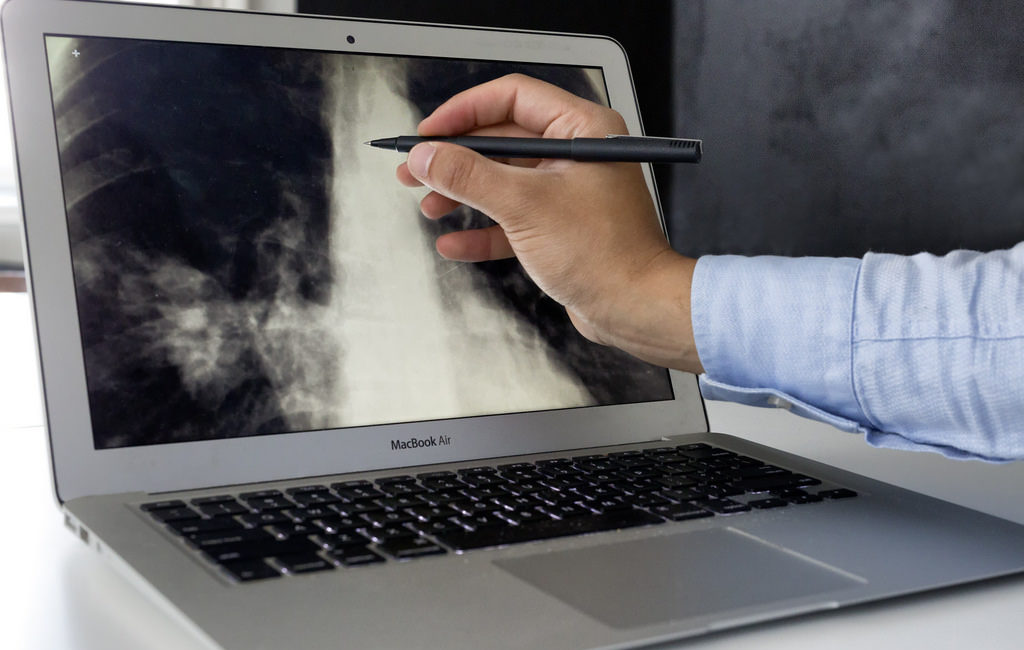The x-ray displaying the neck and skull on the computer screen was enormous. While waiting in the surgeon’s examination room, I studied the image of the contorted structure.
The saying goes, “Someone always has it worse”—well, this someone had it worse: the neck curved in the wrong direction, and a small kink at the base of the skull tilted the head forward as if it was looking over a cliff but terrified of heights.
I couldn’t locate the discs that separate each vertebra bone—the neck and shoulders looked like that damp, San Francisco fog that blows in on cold afternoons—cloudy. Typically, arthritis and bone spurs look shadowy and stiff.
Last year, my family learned a lot about spine health because three of us had experienced invasive surgeries where we received all sorts of metal and screws to straighten our spines. (We should stick together like magnets.)
We had spent so much time with the surgeon that we’re practically on a “we’ll-watch-your-dogs-and-house-when-you-go-on-vacation” basis with him. As a result, I became an armchair spine-and-neck expert. My spine was in bad shape . . . but nothing like the one on the screen!
I heard the doc coming and hopped back up on the patient table.
He sat down at the screen, and I waited for him to pull up my x-rays. But he didn’t. With a shocking realization, I suddenly understood that picture of the contorted neck and skull was MY neck and skull.
He went on to explain my worst fear: in order to fix my spine, I would have to undergo another invasive surgery. It was my only option because I had tried everything else—and this only seven months after enduring what they call one of the most painful surgeries a human being can have.
Still disoriented from the surgeon’s shocking news, somehow I made it to the eye doctor an hour later. My eye doc had asked me to come back to check some abnormalities; because glaucoma runs in my family and we make a living by reading and writing, I sprinted to the appointment.
The exam revealed I needed to see a glaucoma specialist.
Just Forget It!
Before noon, I arrived home . . . soggy, wet eyed, and mind-numb. I had just written a piece on the topic of perspective, and now I wanted to ask the editors to trash it.
I wanted to scratch out every positive quote on post-it notes around my house, throw out all the books on overcoming challenges, delete my motivating TED talks, dump the leadership podcasts, dismiss those great survivor stories, and instead sulk, stomp my feet, and cut off nice people in traffic. I certainly did NOT want to talk with Jesus, even though He had it worse.
My son Jon was home, and he has intuition from the Holy Spirit. Maybe because he has so many limitations, his intuition is one brilliant, bright spot.
There’s no escaping the Holy Spirit, so somehow my son instantly knew something was amiss. Because he’s unable to “fix” most of life, Jon’s learned to deal with life in all its brokenness. He’s so spot on!
When he saw me, he got a tissue box, sat down by my side, and said, “It’s okay to cry, Mom. I’ll just be sad with you.” No questions asked, no explanation needed, my son is a companion who understands what it’s like to have a broken body and to hurt a lot of the time.
Sitting in the silence and trying to sort it all out, I opened the door of conversation with Jesus—okay, I unlocked it—so He could come in as He pleased.

Dealing with It
Weeks passed. I went about helping my mom recover from her nine-hour spine surgery . . .
- I rubbed her feet
- Helped her shower
- Got her a fresh gown
- Dried her hair
- Held her tissue box
And when she hurt so bad she cried, I cried too. Jon joined me and quietly sat in my dad’s recliner and said, “I love you, Nana . . . I’m sorry you’re hurting. I wish I could make it better.”
I read and reread what Margaret, a cancer patient, wrote some time ago, as quoted by Philip Yancey. When people came to visit her in the hospital and she couldn’t talk, she scribbled out these words on a scrap piece of paper:
This is not the worst thing to ever happen! Cancer is so limited. It cannot cripple love, shatter hope, corrode faith, eat away peace, destroy confidence, kill friendship, shut out memories, silence courage, quench the Spirit or lessen the power of Jesus.[ref]Philip Yancey, The Question That Never Goes Away (Grand Rapids: Zondervan, 2013), 104.[/ref]
Let God Use It
Whatever it is, I’m learning it doesn’t have to define you or take you down with it. Reframe it—let God use it to change the way you think, the way you treat others, the way you value life, how you pray and appreciate the abilities you do have.
Let the weakness humble, not harden, you. The its of life can teach us if we are willing to let go of what we think we are or have to be.
Surgery may be in my future—who knows? I’m changing . . . I’m more thankful. Pain and hard times can be transformative when we allow the Lord to lead us.
If anyone had it worse, Jesus did—but look at what the cross did for all creation. Maybe your it is the cross you bear that will influence others. Are you willing to bear it?
Remember, even Jesus cried as He contemplated the cup from which He had to drink. You can cry too . . . I’ll sit with you, hold your hand and your Kleenex, and help you carry your it if you will let me.
Let Me Hear from You
This next week, let’s talk about it and see where life begins to take you.
You can leave a comment by clicking here.
